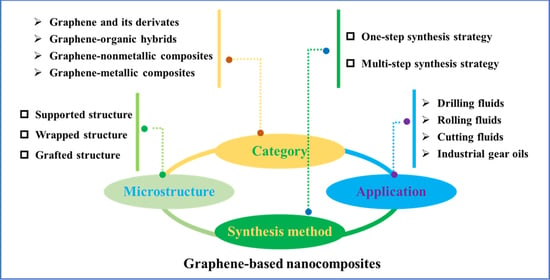Graphene-Based Nanomaterials as Lubricant Additives: A Review
Abstract
1. Introduction
2. Synthesis, Structure, and Lubrication Mechanism of Graphene-Based Nanomaterials
2.1. Synthesis Methods of Graphene-Based Nanomaterials
2.1.1. One-Step Synthesis Strategy for Graphene-Based Nanomaterials
2.1.2. Multi-Step Synthesis Strategy for Graphene-Based Nanomaterials
2.2. Structure of Graphene-Based Nanomaterials
2.3. Lubrication Mechanism of Graphene-Based Nanomaterials
3. Graphene-Based Nanomaterials as Lubricant Additives
3.1. Graphene and Its Derivatives as Lubricant Additives
3.1.1. Graphene Additives
3.1.2. GO Additives
3.1.3. rGO Additives
3.1.4. Doped Graphene Nanosheets
3.1.5. Fluorinated Graphene
3.2. Graphene-Organic Hybrids as Lubricant Additives
3.2.1. Graphene-Organic Compound Hybrids
- Alkylated Compound Modified Graphene
- Amine Compound Modified Graphene
- Other Organic Compound Modified Graphene
3.2.2. Graphene-Polymer Hybrids
- Carbon Chain Polymer Modified Graphene
- Heterochain Polymer Modified Graphene
3.2.3. Surfactant Modified Graphene
3.2.4. Ionic Liquid Modified Graphene
3.3. Graphene-Nonmetallic Nanocomposite Additives
3.3.1. Graphene-Carbon Nanocomposites
3.3.2. Graphene-Nonmetallic Compound Nanocomposites
3.4. Graphene-Metallic Nanocomposites as Lubricant Additives
3.4.1. Graphene-Metal NP Nanocomposites
3.4.2. Graphene-Metal Oxide Nanocomposites
3.4.3. Graphene-Metal Sulfide Nanocomposites
3.4.4. Graphene Combined with Other Metal Containing Compounds
4. Application of Graphene-Based Nanomaterials as Lubricant Additives
4.1. Drilling Fluids
4.2. Rolling Fluids
4.3. Cutting Fluids
4.4. Industrial Gear Oils
5. Conclusions and Outlooks
- (1)
- Some traditionally used organic and inorganic components (such as SDS [122], MoS2 [163], etc.) in the graphene-based nanomaterials contain sulfur elements, which easily cause a release of pollutants. Therefore, preparing “green” graphene-based nanomaterials without reducing friction and wear properties as effective lubricant additives is highly desired.
- (2)
- Different preparation methods or modifiers have a great influence on the antifriction and anti-wear properties of the prepared nanomaterials, making it greatly difficult to provide guidance for the follow-up research. More scientific details, including the degree of modification (the amount of modifier on graphene), the structure-property relationship, and the synergetic effect between different components, etc., need to be further explored.
- (3)
- The dispersion stability of graphene-based nanomaterials in various liquid lubricants has not been fully solved. Specifically, organic modifiers are prone to degrade due to the friction-induced heat during the rubbing process, which leads to re-aggregation of graphene nanosheets in the lubricants. Thus, investigation on materials degradation and long-term stability of graphene-based nanomaterials is still necessary.
- (4)
- As for the lubricating mechanism, systematical elaboration on the lubrication mechanism of different types of graphene-based nanomaterials as lubricant additives is few. It is unclear about the influence of each component on the tribological properties, such as the interaction of additive materials and lubricants, the synergistic lubrication effect of components in nanomaterials, and so on. Combination with advanced characterization techniques and theoretical calculation is needed to further elaborate relevant mechanisms.
- (5)
- Most of the reported graphene-based nanomaterial additives were studied at room temperature and on a laboratory scale. Developing new additives with good tribological property under extreme conditions or in multi-environment is needed in the future. Furthermore, low-cost, large-scale preparation routes, and tribological performance evaluation in real application are crucial for the practical application of these additives.
Author Contributions
Funding
Data Availability Statement
Conflicts of Interest
References
- Holmberg, K.; Andersson, P.; Nylund, N.-O.; Mäkelä, K.; Erdemir, A. Global energy consumption due to friction in trucks and buses. Tribol. Int. 2014, 78, 94–114. [Google Scholar] [CrossRef]
- Mang, T.; Dresel, W. Lubricants and Lubrication; John Wiley & Sons: Hoboken, NJ, USA, 2007. [Google Scholar]
- Rudnick, L.R. Lubricant Additives: Chemistry and Applications; CRC Press: Boca Raton, FL, USA, 2009. [Google Scholar]
- Zhao, J.; Huang, Y.; He, Y.; Shi, Y. Nanolubricant additives: A review. Friction 2021, 9, 891–917. [Google Scholar] [CrossRef]
- Wu, W.; Liu, J.; Li, Z.; Zhao, X.; Liu, G.; Liu, S.; Ma, S.; Li, W.; Liu, W. Surface-functionalized nanoMOFs in oil for friction and wear reduction and antioxidation. Chem. Eng. J. 2021, 410, 128306. [Google Scholar] [CrossRef]
- Cai, M.; Yu, Q.; Liu, W.; Zhou, F. Ionic liquid lubricants: When chemistry meets tribology. Chem. Soc. Rev. 2020, 49, 7753–7818. [Google Scholar] [CrossRef] [PubMed]
- Peeters, S.; Barlini, A.; Jain, J.; Gosvami, N.N.; Righi, M. Adsorption and decomposition of ZDDP on lightweight metallic substrates: Ab initio and experimental insights. Appl. Surf. Sci. 2022, 600, 153947. [Google Scholar] [CrossRef]
- Huang, S.; Wu, H.; Jiang, Z.; Huang, H. Water-based nanosuspensions: Formulation, tribological property, lubrication mechanism, and applications. J. Manuf. Process. 2021, 71, 625–644. [Google Scholar] [CrossRef]
- Zhou, Y.; Qu, J. Ionic liquids as lubricant additives: A review. ACS Appl. Mater. Interfaces 2017, 9, 3209–3222. [Google Scholar] [CrossRef]
- Uflyand, I.E.; Zhinzhilo, V.A.; Burlakova, V.E. Metal-containing nanomaterials as lubricant additives: State-of-the-art and future development. Friction 2019, 7, 93–116. [Google Scholar] [CrossRef]
- Xiao, H.; Liu, S. 2D nanomaterials as lubricant additive: A review. Mater. Des. 2017, 135, 319–332. [Google Scholar] [CrossRef]
- Novoselov, K.S.; Geim, A.K.; Morozov, S.V.; Jiang, D.; Zhang, Y.; Dubonos, S.V.; Grigorieva, I.V.; Firsov, A.A. Electric field effect in atomically thin carbon films. Science 2004, 306, 666–669. [Google Scholar] [CrossRef]
- Rosenkranz, A.; Liu, Y.; Yang, L.; Chen, L. 2D nano-materials beyond graphene: From synthesis to tribological studies. Appl. Nanosci. 2020, 10, 3353–3388. [Google Scholar] [CrossRef]
- Marian, M.; Berman, D.; Nečas, D.; Emani, N.; Ruggiero, A.; Rosenkranz, A. Roadmap for 2D materials in biotribological/biomedical applications—A review. Adv. Colloid Interface Sci. 2022, 307, 102747. [Google Scholar] [CrossRef] [PubMed]
- Marian, M.; Berman, D.; Rota, A.; Jackson, R.L.; Rosenkranz, A. Layered 2D nanomaterials to tailor friction and wear in machine elements-a review. Adv. Mater. Interfaces 2022, 9, 2101622. [Google Scholar] [CrossRef]
- Yang, Y.; Jia, W.; Ma, L.; Zhu, J.; Wang, H.; Hou, K.; Wang, J.; Yang, S. A feasible construction strategy of GO-based hetero-film with long service life at multi-environments: Effective friction transfer application. Tribol. Int. 2022, 168, 107455. [Google Scholar] [CrossRef]
- Berman, D.; Erdemir, A.; Sumant, A.V. Graphene: A new emerging lubricant. Mater. Today 2014, 17, 31–42. [Google Scholar] [CrossRef]
- Wu, P.; Chen, X.; Zhang, C.; Zhang, J.; Luo, J.; Zhang, J. Modified graphene as novel lubricating additive with high dispersion stability in oil. Friction 2021, 9, 143–154. [Google Scholar] [CrossRef]
- Zhang, L.; He, Y.; Zhu, L.; Yang, C.; Niu, Q.; An, C. In situ alkylated graphene as oil dispersible additive for friction and wear reduction. Ind. Eng. Chem. Res. 2017, 56, 9029–9034. [Google Scholar] [CrossRef]
- Spear, J.C.; Ewers, B.W.; Batteas, J.D. 2D-nanomaterials for controlling friction and wear at interfaces. Nano Today 2015, 10, 301–314. [Google Scholar] [CrossRef]
- Chouhan, A.; Mungse, H.P.; Khatri, O.P. Surface chemistry of graphene and graphene oxide: A versatile route for their dispersion and tribological applications. Adv. Colloid Interface Sci. 2020, 283, 102215. [Google Scholar] [CrossRef]
- Sarno, M.; Scarpa, D.; Senatore, A.; Ahmed Abdalglil Mustafa, W. rGO/GO nanosheets in tribology: From the state of the art to the future prospective. Lubricants 2020, 8, 31. [Google Scholar] [CrossRef]
- Liu, Y.; Ge, X.; Li, J. Graphene lubrication. Appl. Mater. Today 2020, 20, 100662. [Google Scholar] [CrossRef]
- Zhao, J.; Gao, T.; Li, Y.; He, Y.; Shi, Y. Two-dimensional (2D) graphene nanosheets as advanced lubricant additives: A critical review and prospect. Mater. Today Commun. 2021, 29, 102755. [Google Scholar] [CrossRef]
- Sun, J.; Du, S. Application of graphene derivatives and their nanocomposites in tribology and lubrication: A review. RSC Adv. 2019, 9, 40642–40661. [Google Scholar] [CrossRef]
- Wang, B.; Ruan, T.; Chen, Y.; Jin, F.; Peng, L.; Zhou, Y.; Wang, D.; Dou, S. Graphene-based composites for electrochemical energy storage. Energy Storage Mater. 2020, 24, 22–51. [Google Scholar] [CrossRef]
- Meng, Y.; Su, F.; Li, Z. Boundary and elastohydrodynamic lubrication behaviors of nano-CuO/reduced graphene oxide nanocomposite as an efficient oil-based additive. Langmuir 2019, 35, 10322–10333. [Google Scholar] [CrossRef]
- Ismail, N.A.; Chowdhury, Z.Z.; Johan, M.R.; Zulkifli, N.W.M. MoS2-Functionalized Graphene Composites-Potential Replacement for Lubricant Friction Modifier and Anti-Wear Additives. Adv. Eng. Mater. 2021, 23, 2100030. [Google Scholar] [CrossRef]
- Sun, J.; Ge, C.; Wang, C.; Li, S. Tribological behavior of graphene oxide-Fe3O4 nanocomposites for additives in water-based lubricants. Fuller. Nanotub. Carbon Nanostructures 2022, 30, 863–872. [Google Scholar] [CrossRef]
- Shi, Q.; Zhu, H. Effects of Ag/RGO composites as lubricant additives on the tribological properties of lubricating oil. Powder Metall. Technol. 2020, 38, 257. [Google Scholar]
- Meng, Y.; Su, F.; Chen, Y. Synthesis of nano-Cu/graphene oxide composites by supercritical CO2-assisted deposition as a novel material for reducing friction and wear. Chem. Eng. J. 2015, 281, 11–19. [Google Scholar] [CrossRef]
- Sammaiah, A.; Huang, W.; Wang, X. Synthesis of magnetic Fe3O4/graphene oxide nanocomposites and their tribological properties under magnetic field. Mater. Res. Express 2018, 5, 105006. [Google Scholar] [CrossRef]
- Min, C.; He, Z.; Liu, D.; Jia, W.; Qian, J.; Jin, Y.; Li, S. Ceria/reduced graphene oxide nanocomposite: Synthesis, characterization, and its lubrication application. ChemistrySelect 2019, 4, 4615–4623. [Google Scholar] [CrossRef]
- Zhou, Q.; Huang, J.; Wang, J.; Yang, Z.; Liu, S.; Wang, Z.; Yang, S. Preparation of a reduced graphene oxide/zirconia nanocomposite and its application as a novel lubricant oil additive. RSC Adv. 2015, 5, 91802–91812. [Google Scholar] [CrossRef]
- Yang, H.; Li, J.-S.; Zeng, X. Correlation between molecular structure and interfacial properties of edge or basal plane modified graphene oxide. ACS Appl. Nano Mater. 2018, 1, 2763–2773. [Google Scholar] [CrossRef]
- Chen, L.; Tu, N.; Wei, Q.; Liu, T.; Li, C.; Wang, W.; Li, J.; Lu, H. Inhibition of cold-welding and adhesive wear occurring on surface of the 6061 aluminum alloy by graphene oxide/polyethylene glycol composite water-based lubricant. Surf. Interface Anal. 2022, 54, 218–230. [Google Scholar] [CrossRef]
- Song, H.; Wang, B.; Zhou, Q.; Xiao, J.; Jia, X. Preparation and tribological properties of MoS2/graphene oxide composites. Appl. Surf. Sci. 2017, 419, 24–34. [Google Scholar] [CrossRef]
- Wang, C.; Sun, J.; Ge, C.; Tang, H.; Wu, P. Synthesis, characterization and lubrication performance of reduced graphene oxide-Al2O3 nanofluid for strips cold rolling. Colloids Surf. A Physicochem. Eng. Asp. 2022, 637, 128204. [Google Scholar] [CrossRef]
- Zhang, L.; He, Y.; Feng, S.; Zhang, L.; Jiao, Z.; Zhan, Y.; Wang, Y. Preparation and tribological properties of novel boehmite/graphene oxide nano-hybrid. Ceram. Int. 2016, 42, 6178–6186. [Google Scholar] [CrossRef]
- Guo, P.; Chen, L.; Wang, J.; Geng, Z.; Lu, Z.; Zhang, G. Enhanced tribological performance of aminated nano-silica modified graphene oxide as water-based lubricant additive. ACS Appl. Nano Mater. 2018, 1, 6444–6453. [Google Scholar] [CrossRef]
- Guo, Y.; Guo, L.; Li, G.; Zhang, L.; Zhao, F.; Wang, C.; Zhang, G. Solvent-free ionic nanofluids based on graphene oxide-silica hybrid as high-performance lubricating additive. Appl. Surf. Sci. 2019, 471, 482–493. [Google Scholar] [CrossRef]
- Luo, J.; Jang, H.D.; Sun, T.; Xiao, L.; He, Z.; Katsoulidis, A.P.; Kanatzidis, M.G.; Gibson, J.M.; Huang, J. Compression and aggregation-resistant particles of crumpled soft sheets. ACS Nano 2011, 5, 8943–8949. [Google Scholar] [CrossRef]
- Dou, X.; Koltonow, A.R.; He, X.; Jang, H.D.; Wang, Q.; Chung, Y.-W.; Huang, J. Self-dispersed crumpled graphene balls in oil for friction and wear reduction. Proc. Natl. Acad. Sci. USA 2016, 113, 1528–1533. [Google Scholar] [CrossRef] [PubMed]
- Jin, B.; Zhao, J.; He, Y.; Chen, G.; Li, Y.; Zhang, C.; Luo, J. High-quality ultra-flat reduced graphene oxide nanosheets with super-robust lubrication performances. Chem. Eng. J. 2022, 438, 135620. [Google Scholar] [CrossRef]
- Zhang, Y.; Chen, P.; Gao, X.; Wang, B.; Liu, H.; Wu, H.; Liu, H.; Dou, S. Nitrogen-Doped Graphene Ribbon Assembled Core-Sheath MnO@Graphene Scrolls as Hierarchically Ordered 3D Porous Electrodes for Fast and Durable Lithium Storage. Adv. Funct. Mater. 2016, 26, 7754–7765. [Google Scholar] [CrossRef]
- Wu, C.; Huang, X.; Xie, L.; Wu, X.; Yu, J.; Jiang, P. Morphology-controllable graphene-TiO2 nanorod hybrid nanostructures for polymer composites with high dielectric performance. J. Mater. Chem. 2011, 21, 17729–17736. [Google Scholar] [CrossRef]
- Zhao, J.; Li, Y.; He, Y.; Luo, J. In situ green synthesis of the new sandwichlike nanostructure of Mn3O4/graphene as lubricant additives. ACS Appl. Mater. Interfaces 2019, 11, 36931–36938. [Google Scholar] [CrossRef]
- Jeong, H.T.; Kim, B.C.; Higgins, M.J.; Wallace, G.G. Highly stretchable reduced graphene oxide (rGO)/single-walled carbon nanotubes (SWNTs) electrodes for energy storage devices. Electrochim. Acta 2015, 163, 149–160. [Google Scholar] [CrossRef]
- Wu, Q.; Xu, Y.; Yao, Z.; Liu, A.; Shi, G. Supercapacitors based on flexible graphene/polyaniline nanofiber composite films. ACS Nano 2010, 4, 1963–1970. [Google Scholar] [CrossRef]
- Zubir, M.N.M.; Badarudin, A.; Kazi, S.; Huang, N.M.; Misran, M.; Sadeghinezhad, E.; Mehrali, M.; Yusoff, N. Highly dispersed reduced graphene oxide and its hybrid complexes as effective additives for improving thermophysical property of heat transfer fluid. Int. J. Heat Mass Transf. 2015, 87, 284–294. [Google Scholar] [CrossRef]
- Zhang, L.; Pu, J.; Wang, L.; Xue, Q. Synergistic effect of hybrid carbon nanotube-graphene oxide as nanoadditive enhancing the frictional properties of ionic liquids in high vacuum. ACS Appl. Mater. Interfaces 2015, 7, 8592–8600. [Google Scholar] [CrossRef]
- Hou, K.; Wang, J.; Yang, Z.; Ma, L.; Wang, Z.; Yang, S. One-pot synthesis of reduced graphene oxide/molybdenum disulfide heterostructures with intrinsic incommensurateness for enhanced lubricating properties. Carbon 2017, 115, 83–94. [Google Scholar] [CrossRef]
- Gu, Y.; Fei, J.; Huang, J.; Zhang, L.; Qu, M.; Zheng, X. Carbon microspheres coated with graphene oxide nanosheets as oil-based additives for tribological applications. Mater. Today Commun. 2020, 25, 101271. [Google Scholar] [CrossRef]
- Luo, T.; Chen, X.C.; Wang, P.; Li, C.C.; Cao, B.Q.; Zeng, H.B. Laser Irradiation-Induced SiC@Graphene Sub-Microspheres: A Bioinspired Core-Shell Structure for Enhanced Tribology Properties. Adv. Mater. Interfaces 2018, 5, 1700839. [Google Scholar] [CrossRef]
- Cai, T.; Liu, D.; Liu, S. Fluid-like graphene oxide organic hybrid materials as efficient anti-wear and friction-reducing additive of polyethylene glycol. Tribol. Int. 2021, 159, 106880. [Google Scholar] [CrossRef]
- Kong, L.; Sun, J.; Bao, Y. Preparation, characterization and tribological mechanism of nanofluids. RSC Adv. 2017, 7, 12599–12609. [Google Scholar] [CrossRef]
- Lin, J.; Wang, L.; Chen, G. Modification of graphene platelets and their tribological properties as a lubricant additive. Tribol. Lett. 2011, 41, 209–215. [Google Scholar] [CrossRef]
- Zhao, W.; Ci, X. TiO2 nanoparticle/fluorinated reduced graphene oxide nanosheet composites for lubrication and wear resistance. ACS Appl. Nano Mater. 2020, 3, 8732–8741. [Google Scholar] [CrossRef]
- Liu, Y.; Yu, S.; Shi, Q.; Ge, X.; Wang, W. Graphene-Family Lubricant Additives: Recent Developments and Future Perspectives. Lubricants 2022, 10, 215. [Google Scholar] [CrossRef]
- Guo, Y.; Zhou, X.; Lee, K.; Yoon, H.C.; Xu, Q.; Wang, D. Recent development in friction of 2D materials: From mechanisms to applications. Nanotechnology 2021, 32, 312002. [Google Scholar] [CrossRef]
- Ren, B.; Gao, L.; Li, M.; Zhang, S.; Ran, X. Tribological properties and anti-wear mechanism of ZnO@graphene core-shell nanoparticles as lubricant additives. Tribol. Int. 2020, 144, 106114. [Google Scholar] [CrossRef]
- Feng, X.; Kwon, S.; Park, J.Y.; Salmeron, M. Superlubric sliding of graphene nanoflakes on graphene. ACS Nano 2013, 7, 1718–1724. [Google Scholar] [CrossRef]
- Guo, Y.; Guo, W.; Chen, C. Modifying atomic-scale friction between two graphene sheets: A molecular-force-field study. Phys. Rev. B 2007, 76, 155429. [Google Scholar] [CrossRef]
- Wang, L.; Gong, P.; Li, W.; Luo, T.; Cao, B. Mono-dispersed Ag/Graphene nanocomposite as lubricant additive to reduce friction and wear. Tribol. Int. 2020, 146, 106228. [Google Scholar] [CrossRef]
- Min, C.; Zhang, Q.; Shen, C.; Liu, D.; Shen, X.; Song, H.; Li, S.; Xu, D.; Lin, X.; Zhang, K. Graphene oxide/carboxyl-functionalized multi-walled carbon nanotube hybrids: Powerful additives for water-based lubrication. RSC Adv. 2017, 7, 32574–32580. [Google Scholar] [CrossRef]
- Alqahtani, B.; Hoziefa, W.; Abdel Moneam, H.M.; Hamoud, M.; Salunkhe, S.; Elshalakany, A.B.; Abdel-Mottaleb, M.; Davim, J.P. Tribological Performance and Rheological Properties of Engine Oil with Graphene Nano-Additives. Lubricants 2022, 10, 137. [Google Scholar] [CrossRef]
- Ismail, N.A.; Zulkifli, N.W.M.; Chowdhury, Z.Z.; Johan, M.R. Functionalization of graphene-based materials: Effective approach for enhancement of tribological performance as lubricant additives. Diam. Relat. Mater. 2021, 115, 108357. [Google Scholar] [CrossRef]
- Lv, J.C.; Zhang, J.P.; Wu, M.Y.; Yin, H.; Liang, G.Q.; Zhang, C.H.; Wei, Y.T. Effect of Oil-Soluble Graphene on the Tribological and Rheological Properties of Magnetorheological Fluids. Adv. Eng. Mater. 2022, 24, 2101602. [Google Scholar] [CrossRef]
- Song, H.-J.; Li, N. Frictional behavior of oxide graphene nanosheets as water-base lubricant additive. Appl. Phys. A 2011, 105, 827–832. [Google Scholar] [CrossRef]
- Liu, Y.; Wang, X.; Pan, G.; Luo, J. A comparative study between graphene oxide and diamond nanoparticles as water-based lubricating additives. Sci. China Technol. Sci. 2013, 56, 152–157. [Google Scholar] [CrossRef]
- Xie, H.; Jiang, B.; Dai, J.; Peng, C.; Li, C.; Li, Q.; Pan, F. Tribological behaviors of graphene and graphene oxide as water-based lubricant additives for magnesium alloy/steel contacts. Materials 2018, 11, 206. [Google Scholar] [CrossRef]
- Elomaa, O.; Singh, V.K.; Iyer, A.; Hakala, T.J.; Koskinen, J. Graphene oxide in water lubrication on diamond-like carbon vs. stainless steel high-load contacts. Diam. Relat. Mater. 2015, 52, 43–48. [Google Scholar] [CrossRef]
- Singh, S.; Chen, X.; Zhang, C.; Tyagi, R.; Luo, J. Investigation on the lubrication potential of graphene oxide aqueous dispersion for self-mated stainless steel tribo-pair. Vacuum 2019, 166, 307–315. [Google Scholar] [CrossRef]
- Kinoshita, H.; Nishina, Y.; Alias, A.A.; Fujii, M. Tribological properties of monolayer graphene oxide sheets as water-based lubricant additives. Carbon 2014, 66, 720–723. [Google Scholar] [CrossRef]
- He, A.; Huang, S.; Yun, J.-H.; Jiang, Z.; Stokes, J.; Jiao, S.; Wang, L.; Huang, H. The pH-dependent structural and tribological behaviour of aqueous graphene oxide suspensions. Tribol. Int. 2017, 116, 460–469. [Google Scholar] [CrossRef]
- Zhao, L.; Yang, H.; Liu, C.; Xue, S.; Deng, Z.; Li, J.; Zeng, X. The correlation between molecular structure and tribological properties of graphene oxide with different oxidation degree. Tribol. Lett. 2019, 67, 85. [Google Scholar] [CrossRef]
- Kumar, P.; Wani, M.F. Tribological characterisation of graphene oxide as lubricant additive on hypereutectic Al-25Si/steel tribopair. Tribol. Trans. 2018, 61, 335–346. [Google Scholar] [CrossRef]
- Xue, S.; Li, H.; Guo, Y.; Zhang, B.; Li, J.; Zeng, X. Water lubrication of graphene oxide-based materials. Friction 2021, 10, 977–1004. [Google Scholar] [CrossRef]
- Konios, D.; Stylianakis, M.M.; Stratakis, E.; Kymakis, E. Dispersion behaviour of graphene oxide and reduced graphene oxide. J. Colloid Interface Sci. 2014, 430, 108–112. [Google Scholar] [CrossRef] [PubMed]
- Ismail, N.A.; Bagheri, S. Highly oil-dispersed functionalized reduced graphene oxide nanosheets as lube oil friction modifier. Mater. Sci. Eng. B 2017, 222, 34–42. [Google Scholar] [CrossRef]
- Gupta, B.; Kumar, N.; Panda, K.; Dash, S.; Tyagi, A. Energy efficient reduced graphene oxide additives: Mechanism of effective lubrication and antiwear properties. Sci. Rep. 2016, 6, 18372. [Google Scholar] [CrossRef]
- Li, Y.; Zhao, J.; Tang, C.; He, Y.; Wang, Y.; Chen, J.; Mao, J.; Zhou, Q.; Wang, B.; Wei, F. Highly exfoliated reduced graphite oxide powders as efficient lubricant oil additives. Adv. Mater. Interfaces 2016, 3, 1600700. [Google Scholar] [CrossRef]
- Schlüter, B.; Mülhaupt, R.; Kailer, A. Synthesis and tribological characterization of stable dispersions of thermally reduced graphite oxide. Tribol. Lett. 2014, 53, 353–363. [Google Scholar] [CrossRef]
- Del Río, J.M.L.; López, E.R.; Fernández, J.; García, F. Tribological properties of dispersions based on reduced graphene oxide sheets and trimethylolpropane trioleate or PAO 40 oils. J. Mol. Liq. 2019, 274, 568–576. [Google Scholar] [CrossRef]
- Kamel, B.M.; Mohamed, A.; El Sherbiny, M.; Abed, K.; Abd-Rabou, M. Tribological properties of graphene nanosheets as an additive in calcium grease. J. Dispers. Sci. Technol. 2017, 38, 1495–1500. [Google Scholar] [CrossRef]
- Zhao, J.; Huang, Y.; Li, Y.; Gao, T.; Dou, Z.; Mao, J.; Wang, H.; He, Y.; Li, S.; Luo, J. Superhigh-exfoliation graphene with a unique two-dimensional (2D) microstructure for lubrication application. Appl. Surf. Sci. 2020, 513, 145608. [Google Scholar] [CrossRef]
- Wang, H.; Maiyalagan, T.; Wang, X. Review on recent progress in nitrogen-doped graphene: Synthesis, characterization, and its potential applications. ACS Catal. 2012, 2, 781–794. [Google Scholar] [CrossRef]
- Jaiswal, V.; Umrao, S.; Rastogi, R.B.; Kumar, R.; Srivastava, A. Synthesis, characterization, and tribological evaluation of TiO2-reinforced boron and nitrogen Co-doped reduced graphene oxide based hybrid nanomaterials as efficient antiwear lubricant additives. ACS Appl. Mater. Interfaces 2016, 8, 11698–11710. [Google Scholar] [CrossRef]
- Chandrabhan, S.R.; Jayan, V.; Parihar, S.S.; Ramaprabhu, S. Development of a nitrogen-doped 2D material for tribological applications in the boundary-lubrication regime. Beilstein J. Nanotechnol. 2017, 8, 1476–1483. [Google Scholar] [CrossRef]
- Wu, Y.; Chen, L.; Qin, S.; Li, J.; Zhou, H.; Chen, J. Functionalized graphene-reinforced rubber composite: Mechanical and tribological behavior study. J. Appl. Polym. Sci. 2017, 134, 44970. [Google Scholar] [CrossRef]
- Xu, L.; Zheng, Y.; Yan, Z.; Zhang, W.; Shi, J.; Zhou, F.; Zhang, X.; Wang, J.; Zhang, J.; Liu, B. Preparation, tribological properties and biocompatibility of fluorinated graphene/ultrahigh molecular weight polyethylene composite materials. Appl. Surf. Sci. 2016, 370, 201–208. [Google Scholar] [CrossRef]
- Fan, K.; Liu, J.; Wang, X.; Liu, Y.; Lai, W.; Gao, S.; Qin, J.; Liu, X. Towards enhanced tribological performance as water-based lubricant additive: Selective fluorination of graphene oxide at mild temperature. J. Colloid Interface Sci. 2018, 531, 138–147. [Google Scholar] [CrossRef]
- Mayrhofer, L.; Moras, G.; Mulakaluri, N.; Rajagopalan, S.; Stevens, P.A.; Moseler, M. Fluorine-terminated diamond surfaces as dense dipole lattices: The electrostatic origin of polar hydrophobicity. J. Am. Chem. Soc. 2016, 138, 4018–4028. [Google Scholar] [CrossRef] [PubMed]
- Min, C.; He, Z.; Song, H.; Liang, H.; Liu, D.; Dong, C.; Jia, W. Fluorinated graphene oxide nanosheet: A highly efficient water-based lubricated additive. Tribol. Int. 2019, 140, 105867. [Google Scholar] [CrossRef]
- Bourlinos, A.B.; Gournis, D.; Petridis, D.; Szabó, T.; Szeri, A.; Dékány, I. Graphite oxide: Chemical reduction to graphite and surface modification with primary aliphatic amines and amino acids. Langmuir 2003, 19, 6050–6055. [Google Scholar] [CrossRef]
- Choudhary, S.; Mungse, H.P.; Khatri, O.P. Dispersion of alkylated graphene in organic solvents and its potential for lubrication applications. J. Mater. Chem. 2012, 22, 21032–21039. [Google Scholar] [CrossRef]
- Zhang, Y.; Zhang, Q.; Peng, Y.; Wang, C.; Chang, X.; Chen, G. Tribological behavior of octadecylamine functionalized graphene oxide modified oil for wire rope in mine hoist. Wear 2022, 494, 204273. [Google Scholar] [CrossRef]
- Mungse, H.P.; Gupta, K.; Singh, R.; Sharma, O.P.; Sugimura, H.; Khatri, O.P. Alkylated graphene oxide and reduced graphene oxide: Grafting density, dispersion stability to enhancement of lubrication properties. J. Colloid Interface Sci. 2019, 541, 150–162. [Google Scholar] [CrossRef]
- Wu, Y.; Zeng, X.; Ren, T.; de Vries, E.; van der Heide, E. The emulsifying and tribological properties of modified graphene oxide in oil-in-water emulsion. Tribol. Int. 2017, 105, 304–316. [Google Scholar] [CrossRef]
- Yang, H.; Li, F.; Shan, C.; Han, D.; Zhang, Q.; Niu, L.; Ivaska, A. Covalent functionalization of chemically converted graphene sheets via silane and its reinforcement. J. Mater. Chem. 2009, 19, 4632–4638. [Google Scholar] [CrossRef]
- Liu, L.; Chen, Y.; Huang, P. Preparation and tribological properties of organically modified graphite oxide in liquid paraffin at ultra-low concentrations. RSC Adv. 2015, 5, 90525–90530. [Google Scholar] [CrossRef]
- Yang, H.; Xue, S.; Zhou, J.; Li, J.; Zeng, X. Interfacial assembly behavior of alkylamine-modulated graphene oxide with different oxidation degrees. Langmuir 2019, 35, 12936–12946. [Google Scholar] [CrossRef]
- Shanmugharaj, A.; Yoon, J.; Yang, W.; Ryu, S.H. Synthesis, characterization, and surface wettability properties of amine functionalized graphene oxide films with varying amine chain lengths. J. Colloid Interface Sci. 2013, 401, 148–154. [Google Scholar] [CrossRef] [PubMed]
- Yang, H.; Zhao, L.; Xue, S.; Deng, Z.; Li, J.; Zeng, X. Branch-chain length modulated graphene oxides for regulating the physicochemical and tribophysical properties of pickering emulsions. Colloids Surf. A Physicochem. Eng. Asp. 2019, 579, 123703. [Google Scholar] [CrossRef]
- Liu, C.; Dong, Y.; Lin, Y.; Yan, H.; Zhang, W.; Bao, Y.; Ma, J. Enhanced mechanical and tribological properties of graphene/bismaleimide composites by using reduced graphene oxide with non-covalent functionalization. Compos. Part B Eng. 2019, 165, 491–499. [Google Scholar] [CrossRef]
- Paul, G.; Shit, S.; Hirani, H.; Kuila, T.; Murmu, N. Tribological behavior of dodecylamine functionalized graphene nanosheets dispersed engine oil nanolubricants. Tribol. Int. 2019, 131, 605–619. [Google Scholar] [CrossRef]
- Ge, X.; Chai, Z.; Shi, Q.; Li, J.; Tang, J.; Liu, Y.; Wang, W. Functionalized graphene-oxide nanosheets with amino groups facilitate macroscale superlubricity. Friction 2022, 10, 1–14. [Google Scholar] [CrossRef]
- Plaza, S.; Margielewski, L.; Celichowski, G.; Wesolowski, R.; Stanecka, R. Tribological performance of some polyoxyethylene dithiophosphate derivatives water solutions. Wear 2001, 249, 1077–1089. [Google Scholar] [CrossRef]
- Zhang, G.; Xu, Y.; Xiang, X.; Zheng, G.; Zeng, X.; Li, Z.; Ren, T.; Zhang, Y. Tribological performances of highly dispersed graphene oxide derivatives in vegetable oil. Tribol. Int. 2018, 126, 39–48. [Google Scholar] [CrossRef]
- Gan, C.; Liang, T.; Li, X.; Li, W.; Li, H.; Fan, X.; Zhu, M. Ultra-dispersive monolayer graphene oxide as water-based lubricant additive: Preparation, characterization and lubricating mechanisms. Tribol. Int. 2021, 155, 106768. [Google Scholar] [CrossRef]
- Ma, J.; Xiao, Y.; Sun, Y.; Hu, J.; Wang, Y. Sulfur-doped alkylated graphene oxide as high-performance lubricant additive. Nanoscale Res. Lett. 2020, 15, 26. [Google Scholar] [CrossRef]
- Sun, J.; Du, S.; Meng, Y.; Wu, P. Analysis of tribological properties of triethanolamine modified graphene oxide additive in water. J. Tribol. 2019, 141, 014501. [Google Scholar] [CrossRef]
- Li, X.; Lu, H.; Li, J.; Dong, G. Preparation and lubricating properties of poly (vinylidene-fluoride) particles wrapped by reduced graphene oxide. Tribol. Int. 2018, 127, 351–360. [Google Scholar] [CrossRef]
- Yang, Y.; Ma, L.; Wang, H.; Jia, W.; Zhu, J.; Wang, J.; Yang, S. A novel water-based lubricating additive of GO@PTFE: Superior tribological performances from the synergistic effect. Tribol. Int. 2022, 169, 107485. [Google Scholar] [CrossRef]
- Kumar, A.; Behera, B.; Thakre, G.D.; Ray, S.S. Covalently grafted graphene oxide/poly (Cn-acrylate) nanocomposites by surface-initiated ATRP: An efficient antifriction, antiwear, and pour-point-depressant lubricating additive in oil media. Ind. Eng. Chem. Res. 2016, 55, 8491–8500. [Google Scholar] [CrossRef]
- Kumar, A.; Behera, B.; Ray, S.S. Microwave-assisted surface-initiated redox polymerization of acrylamide with functionalized graphene oxide for aqueous lubricant additive. RSC Adv. 2015, 5, 39474–39481. [Google Scholar] [CrossRef]
- Liu, C.; Guo, Y.; Wang, D. PEI-RGO nanosheets as a nanoadditive for enhancing the tribological properties of water-based lubricants. Tribol. Int. 2019, 140, 105851. [Google Scholar] [CrossRef]
- Yang, J.; Xia, Y.; Song, H.; Chen, B.; Zhang, Z. Synthesis of the liquid-like graphene with excellent tribological properties. Tribol. Int. 2017, 105, 118–124. [Google Scholar] [CrossRef]
- Wei, Q.; Fu, T.; Yue, Q.; Liu, H.; Ma, S.; Cai, M.; Zhou, F. Graphene oxide/brush-like polysaccharide copolymer nanohybrids as eco-friendly additives for water-based lubrication. Tribol. Int. 2021, 157, 106895. [Google Scholar] [CrossRef]
- Paramashivaiah, B.; Rajashekhar, C. Studies on Effect of Various Surfactants on Stable Dispersion of Graphene Nano Particles in Simarouba Biodiesel; IOP Conference Series: Materials Science and Engineering; IOP Publishing: Bristol, UK, 2016; p. 012083. [Google Scholar]
- Mao, Y.; Fan, Q.; Li, J.; Yu, L.; Qu, L. A novel and green CTAB-functionalized graphene nanosheets electrochemical sensor for Sudan I determination. Sens. Actuators B Chem. 2014, 203, 759–765. [Google Scholar] [CrossRef]
- Peng, Y.; Wang, Z. Tribological properties of sodium dodecyl sulfate aqueous dispersion of graphite-derived carbon materials. RSC Adv. 2014, 4, 9980–9985. [Google Scholar] [CrossRef]
- Hu, Y.; Wang, Y.; Zeng, Z.; Zhao, H.; Li, J.; Ge, X.; Wang, L.; Xue, Q.; Mao, C.; Chen, S. BLG-RGO: A novel nanoadditive for water-based lubricant. Tribol. Int. 2019, 135, 277–286. [Google Scholar] [CrossRef]
- Ye, C.; Liu, W.; Chen, Y.; Yu, L. Room-temperature ionic liquids: A novel versatile lubricant. Chem. Commun. 2001, 21, 2244–2245. [Google Scholar] [CrossRef] [PubMed]
- Fan, X.; Wang, L. High-performance lubricant additives based on modified graphene oxide by ionic liquids. J. Colloid Interface Sci. 2015, 452, 98–108. [Google Scholar] [CrossRef] [PubMed]
- Gan, C.; Liang, T.; Li, W.; Fan, X.; Li, X.; Li, D.; Zhu, M. Hydroxyl-terminated ionic liquids functionalized graphene oxide with good dispersion and lubrication function. Tribol. Int. 2020, 148, 106350. [Google Scholar] [CrossRef]
- Song, W.; Chen, P.; Yan, J.; Zhu, W.; Ji, H. The tribological properties of reduced graphene oxide doped by N and B species with different configurations. ACS Appl. Mater. Interfaces 2020, 12, 29737–29746. [Google Scholar] [CrossRef]
- Gan, C.; Liang, T.; Li, W.; Fan, X.; Zhu, M. Amine-terminated ionic liquid modified graphene oxide/copper nanocomposite toward efficient lubrication. Appl. Surf. Sci. 2019, 491, 105–115. [Google Scholar] [CrossRef]
- Song, W.; Yan, J.; Ji, H. Tribological performance of an imidazolium ionic liquid-functionalized SiO2@graphene oxide as an additive. ACS Appl. Mater. Interfaces 2021, 13, 50573–50583. [Google Scholar] [CrossRef]
- Zhai, W.; Srikanth, N.; Kong, L.B.; Zhou, K. Carbon nanomaterials in tribology. Carbon 2017, 119, 150–171. [Google Scholar] [CrossRef]
- Ma, W.; Gong, Z.; Gao, K.; Qiang, L.; Zhang, J.; Yu, S. Superlubricity achieved by carbon quantum dots in ionic liquid. Mater. Lett. 2017, 195, 220–223. [Google Scholar] [CrossRef]
- Peng, D.X.; Kang, Y.; Chen, C.H.; Chen, S.K.; Shu, F.C. The tribological behavior of modified diamond nanoparticles in liquid paraffin. Ind. Lubr. Tribol. 2009, 61, 213–219. [Google Scholar] [CrossRef]
- Ku, B.-C.; Han, Y.-C.; Lee, J.-E.; Lee, J.-K.; Park, S.-H.; Hwang, Y.-J. Tribological effects of fullerene (C60) nanoparticles added in mineral lubricants according to its viscosity. Int. J. Precis. Eng. Manuf. 2010, 11, 607–611. [Google Scholar] [CrossRef]
- Wu, P.; Chen, X.; Zhang, C.; Luo, J. Synergistic tribological behaviors of graphene oxide and nanodiamond as lubricating additives in water. Tribol. Int. 2019, 132, 177–184. [Google Scholar] [CrossRef]
- Shang, W.; Cai, T.; Zhang, Y.; Liu, D.; Liu, S. Facile one pot pyrolysis synthesis of carbon quantum dots and graphene oxide nanomaterials: All carbon hybrids as eco-environmental lubricants for low friction and remarkable wear-resistance. Tribol. Int. 2018, 118, 373–380. [Google Scholar] [CrossRef]
- Meng, H.; Sui, G.; Xie, G.; Yang, R. Friction and wear behavior of carbon nanotubes reinforced polyamide 6 composites under dry sliding and water lubricated condition. Compos. Sci. Technol. 2009, 69, 606–611. [Google Scholar] [CrossRef]
- Nie, P.; Min, C.; Song, H.-J.; Chen, X.; Zhang, Z.; Zhao, K. Preparation and tribological properties of polyimide/carboxyl-functionalized multi-walled carbon nanotube nanocomposite films under seawater lubrication. Tribol. Lett. 2015, 58, 7. [Google Scholar] [CrossRef]
- Lv, T.; Huang, S.; Hu, X.; Ma, Y.; Xu, X. Tribological and machining characteristics of a minimum quantity lubrication (MQL) technology using GO/SiO2 hybrid nanoparticle water-based lubricants as cutting fluids. Int. J. Adv. Manuf. Technol. 2018, 96, 2931–2942. [Google Scholar] [CrossRef]
- Huang, S.; Li, X.; Yu, B.; Jiang, Z.; Huang, H. Machining characteristics and mechanism of GO/SiO2 nanoslurries in fixed abrasive lapping. J. Mater. Process. Technol. 2020, 277, 116444. [Google Scholar] [CrossRef]
- Singh, V.K.; Elomaa, O.; Johansson, L.-S.; Hannula, S.-P.; Koskinen, J. Lubricating properties of silica/graphene oxide composite powders. Carbon 2014, 79, 227–235. [Google Scholar] [CrossRef]
- Liu, X.; Yamaguchi, R.; Umehara, N.; Deng, X.; Kousaka, H.; Murashima, M. Clarification of high wear resistance mechanism of ta-CNx coating under poly alpha-olefin (PAO) lubrication. Tribol. Int. 2017, 105, 193–200. [Google Scholar] [CrossRef]
- He, A.; Huang, S.; Yun, J.-H.; Jiang, Z.; Stokes, J.R.; Jiao, S.; Wang, L.; Huang, H. Tribological characteristics of aqueous graphene oxide, graphitic carbon nitride, and their mixed suspensions. Tribol. Lett. 2018, 66, 42. [Google Scholar] [CrossRef]
- Cho, D.-H.; Kim, J.-S.; Kwon, S.-H.; Lee, C.; Lee, Y.-Z. Evaluation of hexagonal boron nitride nano-sheets as a lubricant additive in water. Wear 2013, 302, 981–986. [Google Scholar] [CrossRef]
- Liu, Y.; Liu, C.; Li, Z.; Su, F. Preparation and Tribological Properties of h-BN Dotted with Cu Nanoparticles as Lubricant Additive. Lubr. Eng. 2022, 47, 122–128. [Google Scholar]
- Samanta, S.; Sahoo, R.R. Covalently linked hexagonal boron nitride-graphene oxide nanocomposites as high-performance oil-dispersible lubricant additives. ACS Appl. Nano Mater. 2020, 3, 10941–10953. [Google Scholar] [CrossRef]
- Liu, L.; Zhou, M.; Li, X.; Jin, L.; Su, G.; Mo, Y.; Li, L.; Zhu, H.; Tian, Y. Research progress in application of 2D materials in liquid-phase lubrication system. Materials 2018, 11, 1314. [Google Scholar] [CrossRef] [PubMed]
- Nie, H.; Fu, L.; Zhu, J.; Yang, W.; Li, D.; Zhou, L. Excellent tribological properties of lower reduced graphene oxide content copper composite by using a one-step reduction molecular-level mixing process. Materials 2018, 11, 600. [Google Scholar] [CrossRef]
- Jia, Z.; Chen, T.; Wang, J.; Ni, J.; Li, H.; Shao, X. Synthesis, characterization and tribological properties of Cu/reduced graphene oxide composites. Tribol. Int. 2015, 88, 17–24. [Google Scholar] [CrossRef]
- Sharma, A.K.; Tiwari, A.K.; Dixit, A.R.; Singh, R.K.; Singh, M. Novel uses of alumina/graphene hybrid nanoparticle additives for improved tribological properties of lubricant in turning operation. Tribol. Int. 2018, 119, 99–111. [Google Scholar] [CrossRef]
- Zhang, Y.; Erkey, C. Preparation of supported metallic nanoparticles using supercritical fluids: A review. J. Supercrit. Fluids 2006, 38, 252–267. [Google Scholar] [CrossRef]
- Meng, Y.; Su, F.; Chen, Y. A novel nanomaterial of graphene oxide dotted with Ni nanoparticles produced by supercritical CO2-assisted deposition for reducing friction and wear. ACS Appl. Mater. Interfaces 2015, 7, 11604–11612. [Google Scholar] [CrossRef]
- Meng, Y.; Su, F.; Chen, Y. Au/graphene oxide nanocomposite synthesized in supercritical CO2 fluid as energy efficient lubricant additive. ACS Appl. Mater. Interfaces 2017, 9, 39549–39559. [Google Scholar] [CrossRef]
- Song, H.-J.; Jia, X.-H.; Li, N.; Yang, X.-F.; Tang, H. Synthesis of α-Fe2O3 nanorod/graphene oxide composites and their tribological properties. J. Mater. Chem. 2012, 22, 895–902. [Google Scholar] [CrossRef]
- Huang, S.; Lin, W.; Li, X.; Fan, Z.; Wu, H.; Jiang, Z.; Huang, H. Roughness-dependent tribological characteristics of water-based GO suspensions with ZrO2 and TiO2 nanoparticles as additives. Tribol. Int. 2021, 161, 107073. [Google Scholar] [CrossRef]
- Huang, S.; Wang, Z.; Xu, L.; Huang, C. Friction and Wear Characteristics of Aqueous ZrO2/GO Hybrid Nanolubricants. Lubricants 2022, 10, 109. [Google Scholar] [CrossRef]
- Zhou, S.; Liu, H.; Wang, S.; Gan, L.; Huang, J.; Zhao, G.; Liu, Y. Tribological performance of electrostatic self-assembly prepared ZrO2@GO nanocomposites using as lubricant additive. Mater. Res. Express 2019, 6, 115075. [Google Scholar] [CrossRef]
- Ma, L.; Li, Z.; Hou, K.; Jia, W.; Wang, J.; Yang, S. Sonication-assisted solvothermal synthesis of noncovalent fluorographene/ceria nanocomposite with excellent extreme-pressure and anti-wear properties. Tribol. Int. 2021, 159, 106991. [Google Scholar] [CrossRef]
- Luo, T.; Wei, X.; Huang, X.; Huang, L.; Yang, F. Tribological properties of Al2O3 nanoparticles as lubricating oil additives. Ceram. Int. 2014, 40, 7143–7149. [Google Scholar] [CrossRef]
- Huang, S.; He, A.; Yun, J.-H.; Xu, X.; Jiang, Z.; Jiao, S.; Huang, H. Synergistic tribological performance of a water based lubricant using graphene oxide and alumina hybrid nanoparticles as additives. Tribology International 2019, 135, 170–180. [Google Scholar] [CrossRef]
- Huang, S.; Li, X.; Zhao, Y.; Sun, Q.; Huang, H. A novel lapping process for single-crystal sapphire using hybrid nanoparticle suspensions. Int. J. Mech. Sci. 2021, 191, 106099. [Google Scholar] [CrossRef]
- Gusain, R.; Khatri, O.P. Ultrasound assisted shape regulation of CuO nanorods in ionic liquids and their use as energy efficient lubricant additives. J. Mater. Chem. A 2013, 1, 5612–5619. [Google Scholar] [CrossRef]
- Hou, K.; Han, M.; Liu, X.; Wang, J.; He, Y.; Yang, S. In situ formation of spherical MoS2 nanoparticles for ultra-low friction. Nanoscale 2018, 10, 19979–19986. [Google Scholar] [CrossRef]
- Wu, J.; Mu, L.; Zhu, J.; Feng, X.; Lu, X.; Larsson, R.; Shi, Y. Synthesis of hollow fullerene-like molybdenum disulfide/reduced graphene oxide nanocomposites with excellent lubricating properties. Carbon 2018, 134, 423–430. [Google Scholar] [CrossRef]
- Zhao, J.; He, Y.; Wang, Y.; Wang, W.; Yan, L.; Luo, J. An investigation on the tribological properties of multilayer graphene and MoS2 nanosheets as additives used in hydraulic applications. Tribol. Int. 2016, 97, 14–20. [Google Scholar] [CrossRef]
- Xin, Y.; Li, T.; Gong, D.; Xu, F.; Wang, M. Preparation and tribological properties of graphene oxide/nano-MoS2 hybrid as multidimensional assembly used in the polyimide nanocomposites. RSC Adv. 2017, 7, 6323–6335. [Google Scholar] [CrossRef]
- Zhang, M.; Chen, B.; Tang, H.; Tang, G.; Li, C.; Chen, L.; Zhang, H.; Zhang, Q. Hydrothermal synthesis and tribological properties of FeS2 (pyrite)/reduced graphene oxide heterojunction. RSC Adv. 2015, 5, 1417–1423. [Google Scholar] [CrossRef]
- Zheng, D.; Wu, Y.; Li, Z.; Cai, Z. Tribological properties of WS2/graphene nanocomposites as lubricating oil additives. RSC Adv. 2017, 7, 14060–14068. [Google Scholar] [CrossRef]
- Zhou, C.; Li, Z.; Liu, S.; Zhan, T.; Li, W.; Wang, J. Layered double hydroxides for tribological application: Recent advances and future prospective. Appl. Clay Sci. 2022, 221, 106466. [Google Scholar] [CrossRef]
- Wyatt, B.C.; Rosenkranz, A.; Anasori, B. 2D MXenes: Tunable mechanical and tribological properties. Adv. Mater. 2021, 33, 2007973. [Google Scholar] [CrossRef]
- Miao, X.; Li, Z.; Liu, S.; Wang, J.; Yang, S. MXenes in tribology: Current status and perspectives. Adv. Powder Mater. 2022, in press. [Google Scholar] [CrossRef]
- Wang, J.; Liu, T. Study on the Tribological Properties of FTDS/ZnFe-LDH Composite Lubricating Material. Appl. Sci. 2022, 12, 599. [Google Scholar] [CrossRef]
- Wang, H.; Liu, Y.; Liu, W.; Wang, R.; Wen, J.; Sheng, H.; Peng, J.; Erdemir, A.; Luo, J. Tribological behavior of NiAl-layered double hydroxide nanoplatelets as oil-based lubricant additives. ACS Appl. Mater. Interfaces 2017, 9, 30891–30899. [Google Scholar] [CrossRef]
- Malaki, M.; Varma, R.S. Mechanotribological aspects of MXene-reinforced nanocomposites. Adv. Mater. 2020, 32, 2003154. [Google Scholar] [CrossRef]
- Ba, Z.; Han, Y.; Qiao, D.; Feng, D.; Huang, G. Composite nanoparticles based on hydrotalcite as high performance lubricant additives. Ind. Eng. Chem. Res. 2018, 57, 15225–15233. [Google Scholar] [CrossRef]
- Li, Z.; Hou, X.; Yu, L.; Zhang, Z.; Zhang, P. Preparation of lanthanum trifluoride nanoparticles surface-capped by tributyl phosphate and evaluation of their tribological properties as lubricant additive in liquid paraffin. Appl. Surf. Sci. 2014, 292, 971–977. [Google Scholar] [CrossRef]
- Hou, X.; Yang, C.; He, J.; Li, Z.; Zhang, Z. Preparation and tribological properties of lanthanum trifluoride nanoparticles-decorated graphene oxide nanosheets. Ind. Eng. Chem. Res. 2015, 54, 4773–4780. [Google Scholar] [CrossRef]
- Yang, C.; Hou, X.; Li, Z.; Li, X.; Yu, L.; Zhang, Z. Preparation of surface-modified lanthanum fluoride–graphene oxide nanohybrids and evaluation of their tribological properties as lubricant additive in liquid paraffin. Appl. Surf. Sci. 2016, 388, 497–502. [Google Scholar] [CrossRef]
- Cheng, Z.-L.; Li, W.; Liu, Z. Preparation, characterization, and tribological properties of oleic diethanolamide-capped zinc borate-coated graphene oxide composites. J. Alloy. Compd. 2017, 705, 384–391. [Google Scholar] [CrossRef]
- Song, H.; Wang, Z.; Yang, J.; Jia, X.; Zhang, Z. Facile synthesis of copper/polydopamine functionalized graphene oxide nanocomposites with enhanced tribological performance. Chem. Eng. J. 2017, 324, 51–62. [Google Scholar] [CrossRef]
- Mu, L.; Cao, D.; Zhuang, W.; Yu, Q.; Cai, M.; Shi, Y. Stable dispersed zeolitic imidazolate framework/graphene oxide nanocomposites in ionic liquids resulting in high lubricating performance. Adv. Mater. Interfaces 2020, 7, 1902194. [Google Scholar] [CrossRef]
- Ma, J.; Xu, J.; Pang, S.; Zhou, W.; Xia, B.; An, Y. Novel environmentally friendly lubricants for drilling fluids applied in shale formation. Energy Fuels 2021, 35, 8153–8162. [Google Scholar] [CrossRef]
- Tian, X.; Song, N.; Yang, G.; Zhou, C.; Zhang, S.; Zhang, P. Organic-sulfonate functionalized graphene as a high temperature lubricant for efficient antifriction and antiwear in water based drilling fluid. Tribol. Lett. 2022, 70, 32. [Google Scholar] [CrossRef]
- Zhu, Z.; Sun, J.; Niu, T.; Liu, N. Experimental research on tribological performance of water-based rolling liquid containing nano-TiO2. Proc. Inst. Mech. Eng. Part N J. Nanoeng. Nanosyst. 2015, 229, 104–109. [Google Scholar] [CrossRef]
- Du, S.; Sun, J.; Wu, P. Preparation, characterization and lubrication performances of graphene oxide-TiO2 nanofluid in rolling strips. Carbon 2018, 140, 338–351. [Google Scholar] [CrossRef]
- Xie, H.; Dang, S.; Jiang, B.; Xiang, L.; Zhou, S.; Sheng, H.; Yang, T.; Pan, F. Tribological performances of SiO2/graphene combinations as water-based lubricant additives for magnesium alloy rolling. Appl. Surf. Sci. 2019, 475, 847–856. [Google Scholar] [CrossRef]
- Ibrahim, A.M.M.; Li, W.; Xiao, H.; Zeng, Z.; Ren, Y.; Alsoufi, M.S. Energy conservation and environmental sustainability during grinding operation of Ti-6Al-4V alloys via eco-friendly oil/graphene nano additive and Minimum quantity lubrication. Tribol. Int. 2020, 150, 106387. [Google Scholar] [CrossRef]
- Junior, A.S.A.; Sales, W.F.; da Silva, R.B.; Costa, E.S.; Machado, Á.R. Lubri-cooling and tribological behavior of vegetable oils during milling of AISI 1045 steel focusing on sustainable manufacturing. J. Clean. Prod. 2017, 156, 635–647. [Google Scholar] [CrossRef]
- Zheng, D.; Cai, Z.; Shen, M.; Li, Z.; Zhu, M. Investigation of the tribology behaviour of the graphene nanosheets as oil additives on textured alloy cast iron surface. Appl. Surf. Sci. 2016, 387, 66–75. [Google Scholar] [CrossRef]
- Fan, X.; Li, X.; Zhao, Z.; Yue, Z.; Feng, P.; Ma, X.; Li, H.; Ye, X.; Zhu, M. Heterostructured rGO/MoS2 nanocomposites toward enhancing lubrication function of industrial gear oils. Carbon 2022, 191, 84–97. [Google Scholar] [CrossRef]
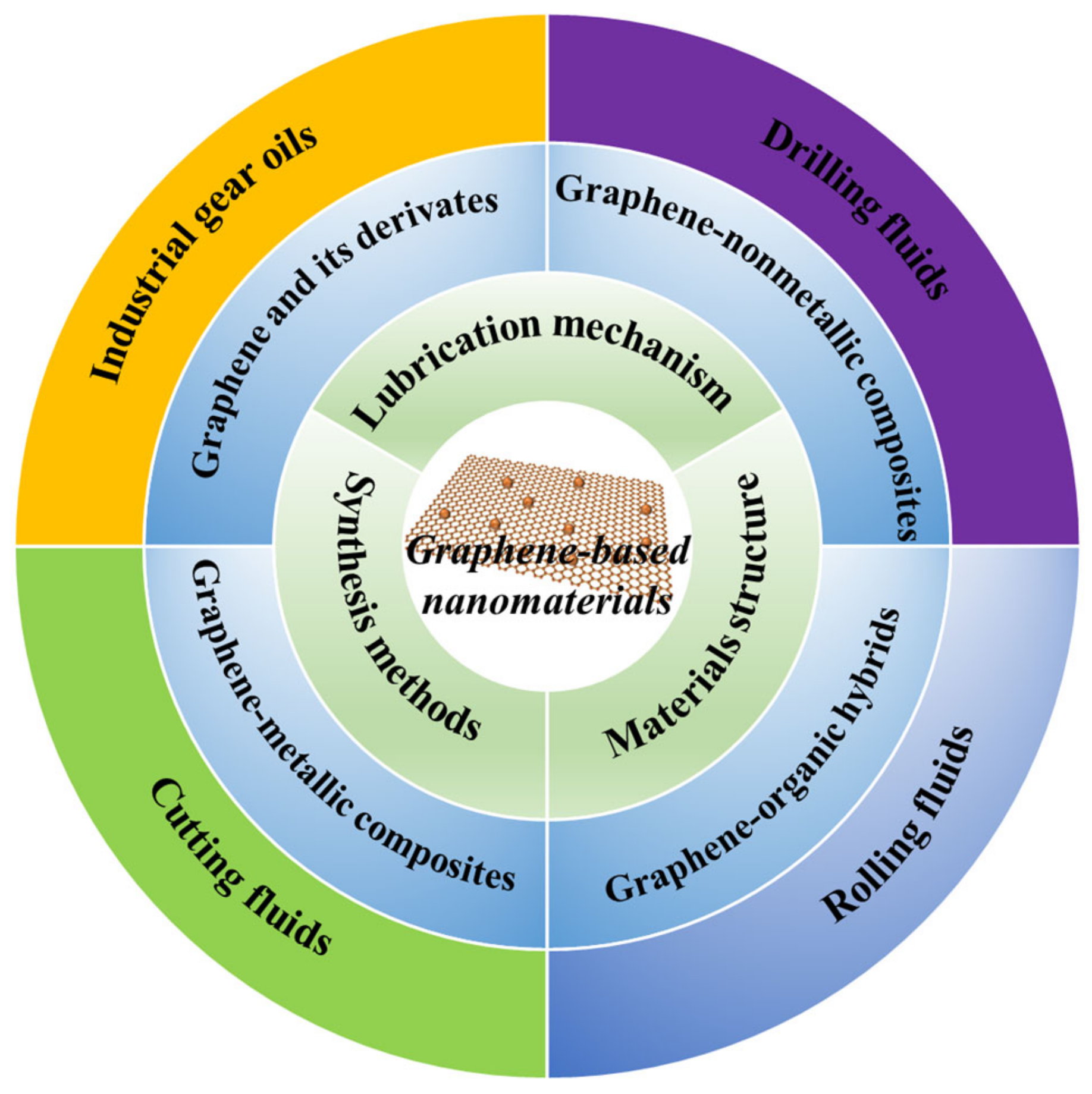
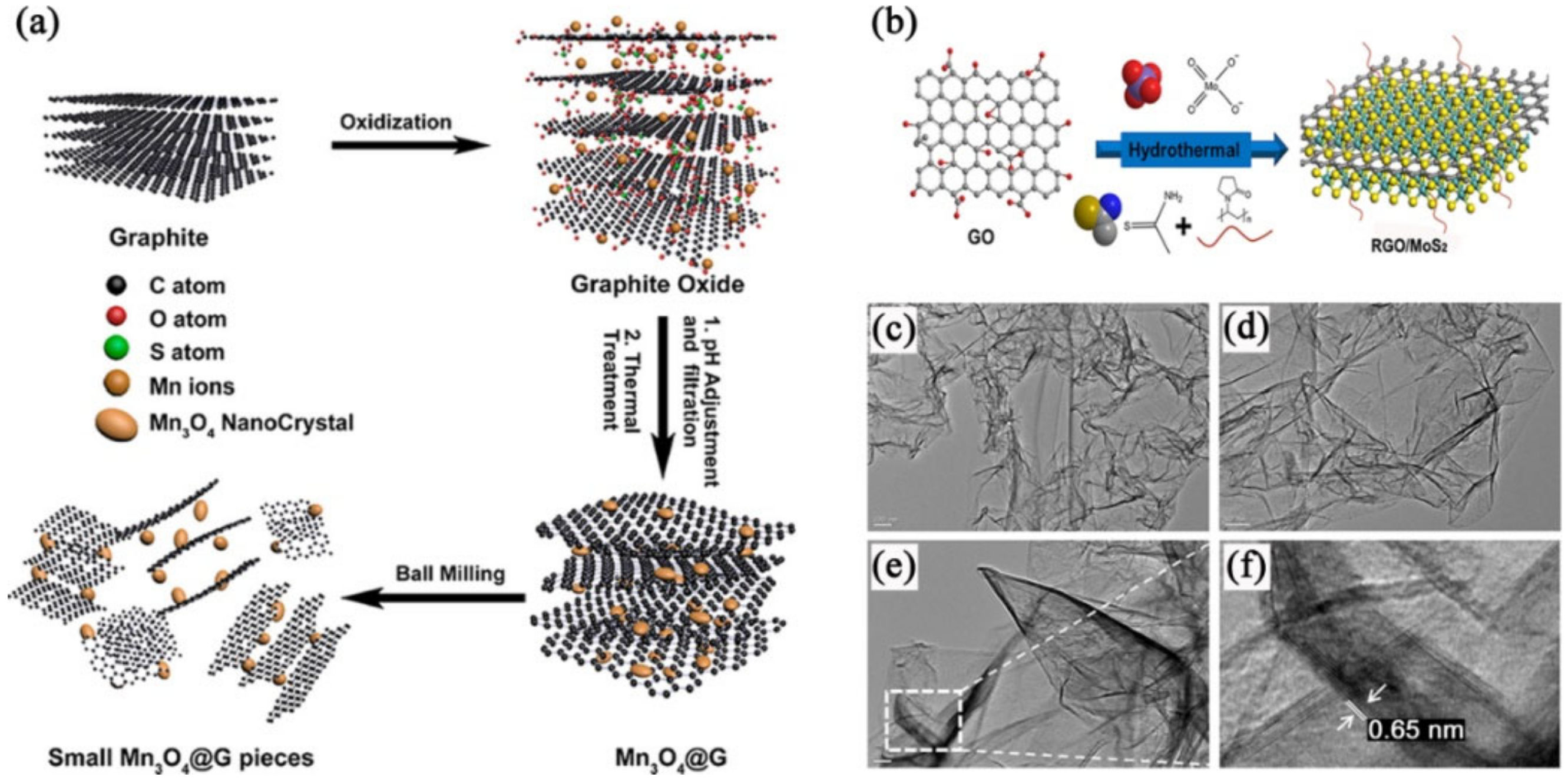
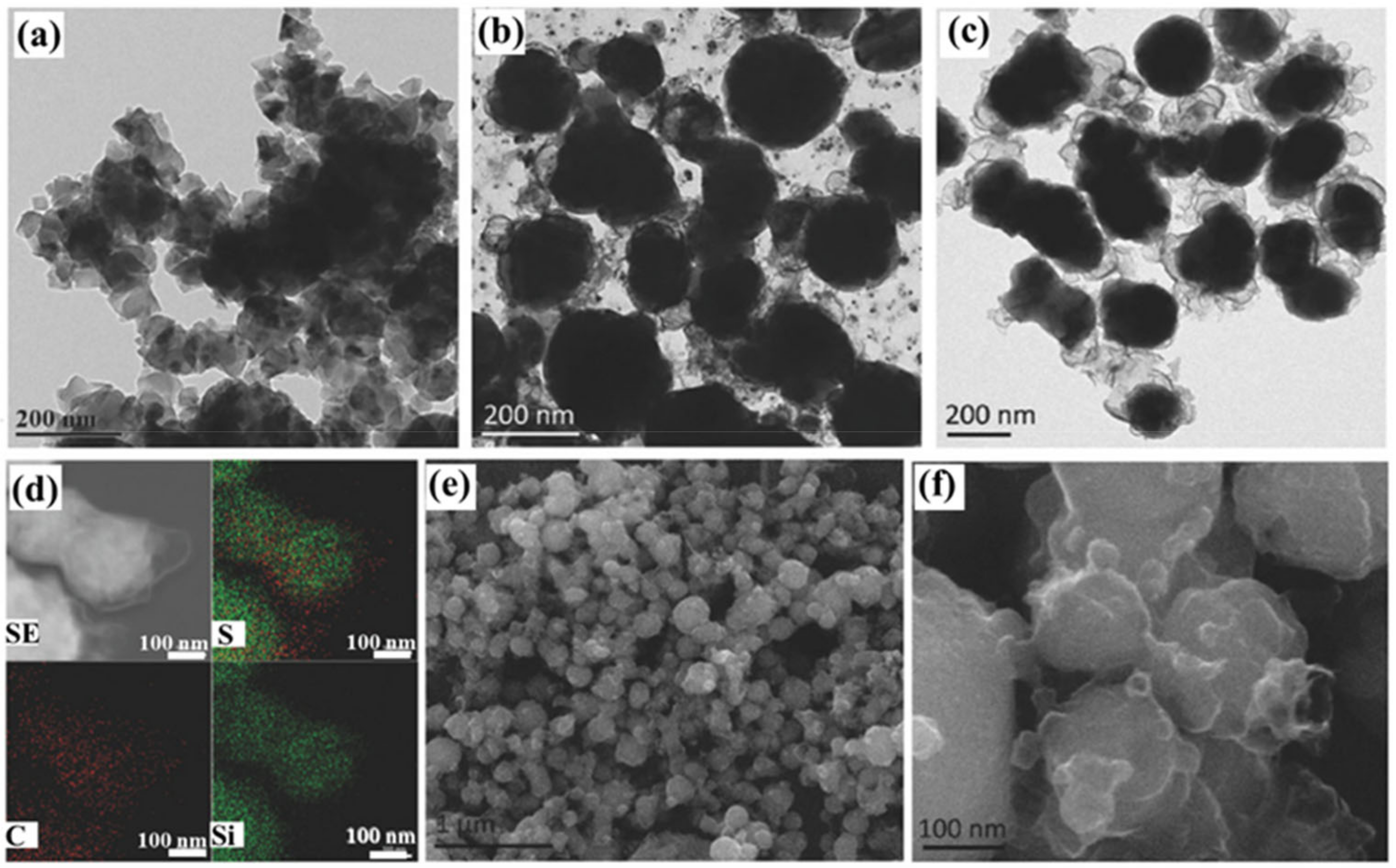
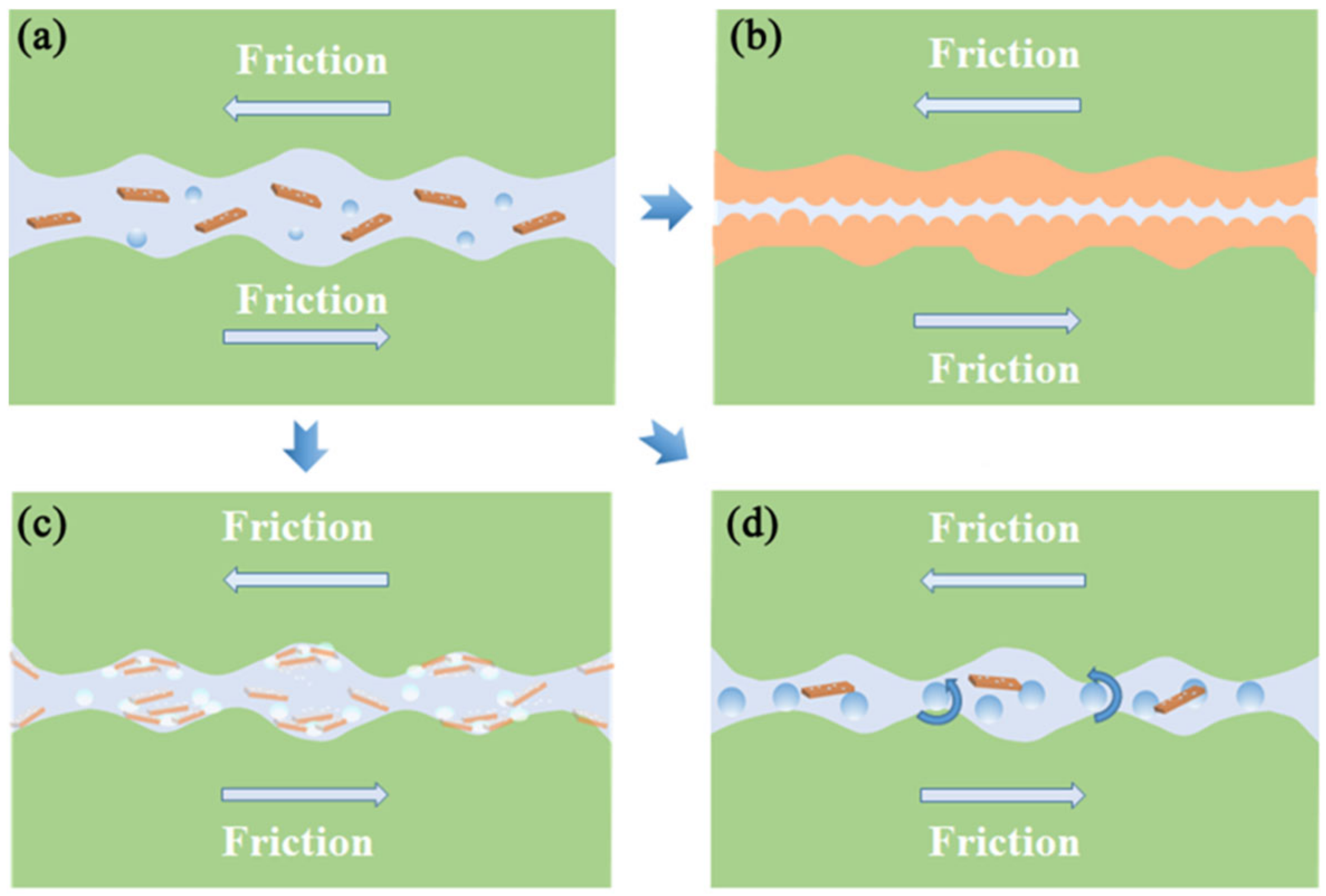

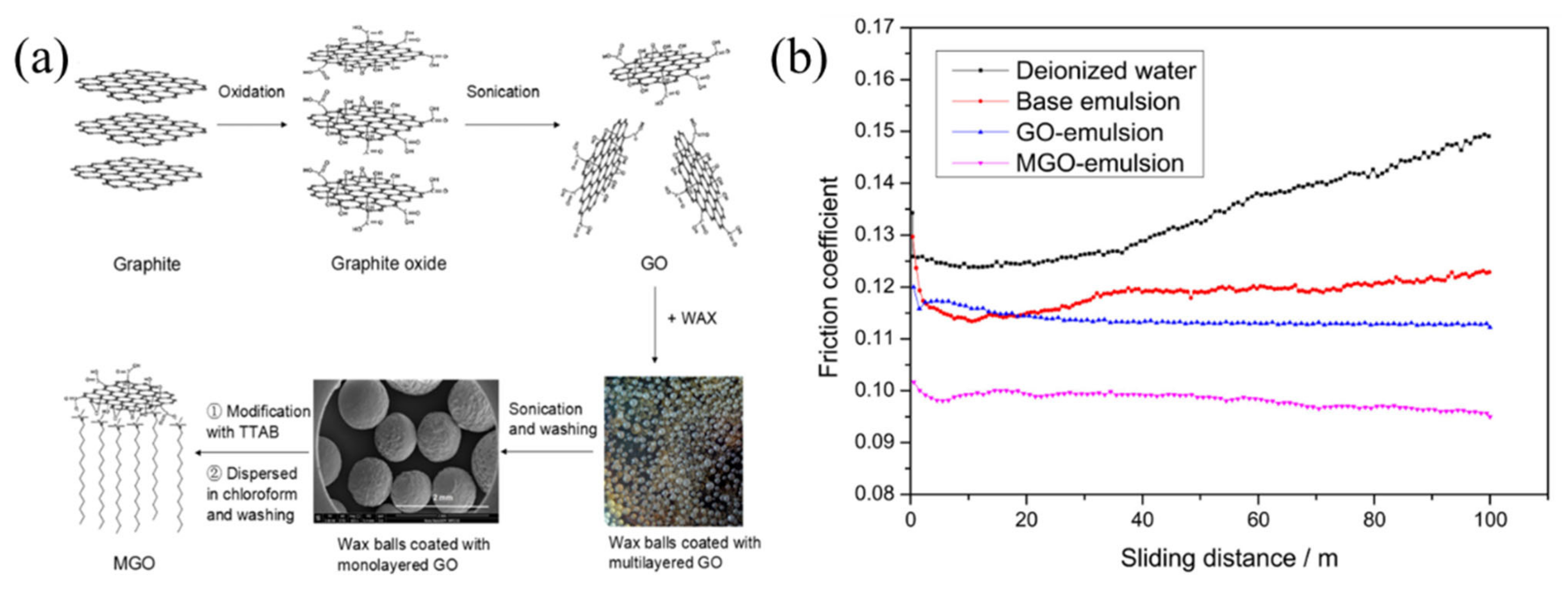
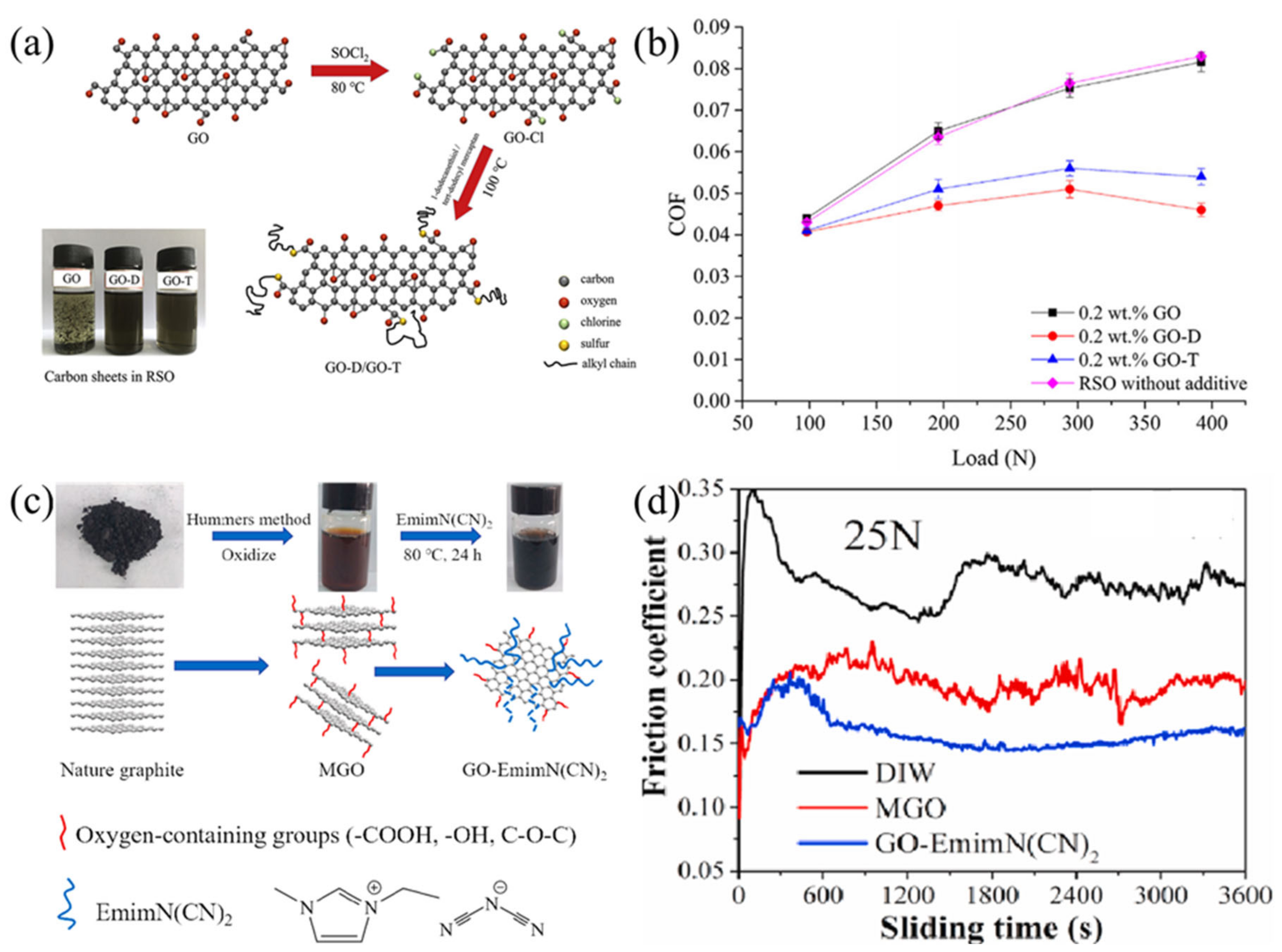




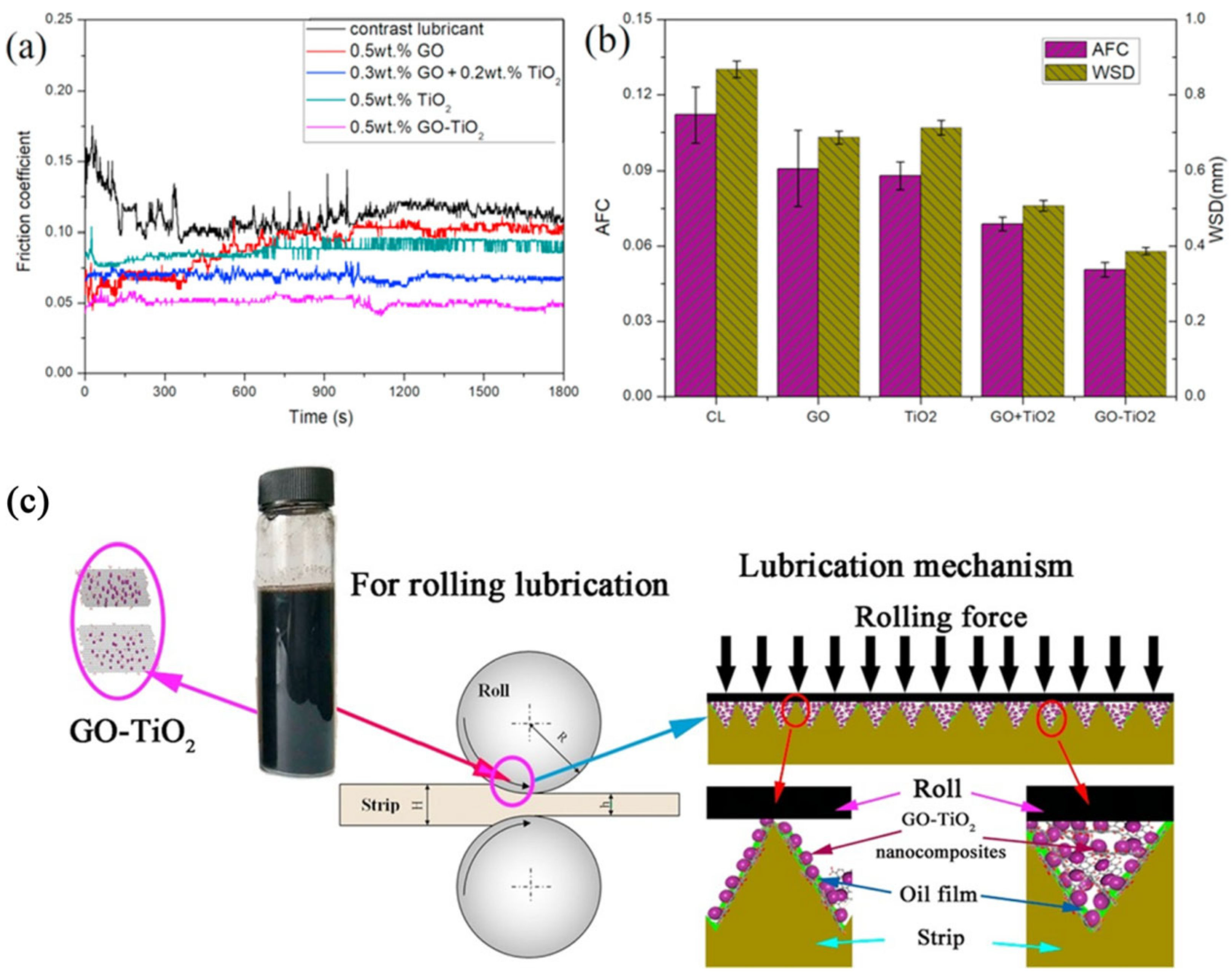
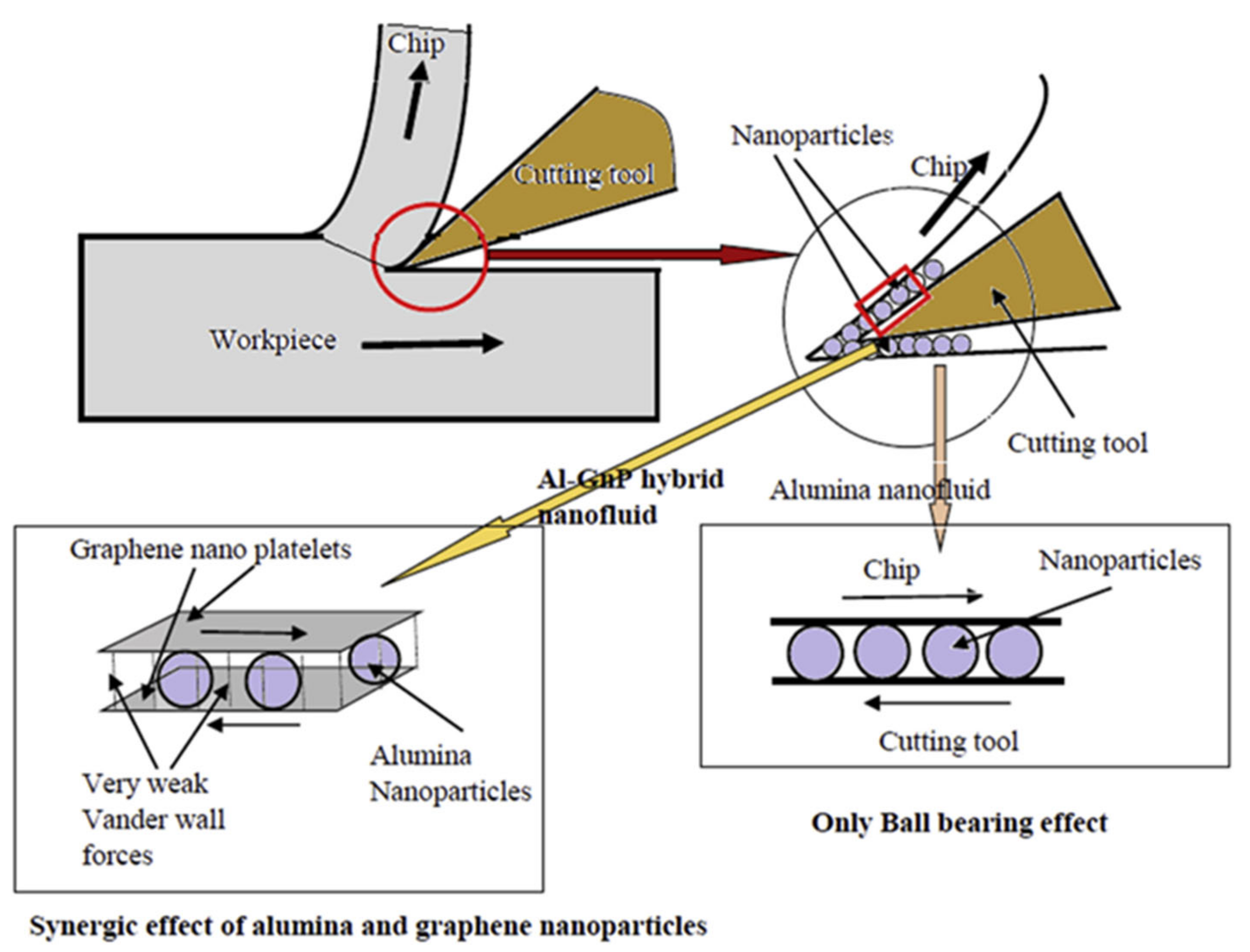
Publisher’s Note: MDPI stays neutral with regard to jurisdictional claims in published maps and institutional affiliations. |
© 2022 by the authors. Licensee MDPI, Basel, Switzerland. This article is an open access article distributed under the terms and conditions of the Creative Commons Attribution (CC BY) license (https://creativecommons.org/licenses/by/4.0/).
Share and Cite
Gao, Q.; Liu, S.; Hou, K.; Li, Z.; Wang, J. Graphene-Based Nanomaterials as Lubricant Additives: A Review. Lubricants 2022, 10, 273. https://doi.org/10.3390/lubricants10100273
Gao Q, Liu S, Hou K, Li Z, Wang J. Graphene-Based Nanomaterials as Lubricant Additives: A Review. Lubricants. 2022; 10(10):273. https://doi.org/10.3390/lubricants10100273
Chicago/Turabian StyleGao, Qiulong, Shuwen Liu, Kaiming Hou, Zhangpeng Li, and Jinqing Wang. 2022. "Graphene-Based Nanomaterials as Lubricant Additives: A Review" Lubricants 10, no. 10: 273. https://doi.org/10.3390/lubricants10100273
APA StyleGao, Q., Liu, S., Hou, K., Li, Z., & Wang, J. (2022). Graphene-Based Nanomaterials as Lubricant Additives: A Review. Lubricants, 10(10), 273. https://doi.org/10.3390/lubricants10100273





